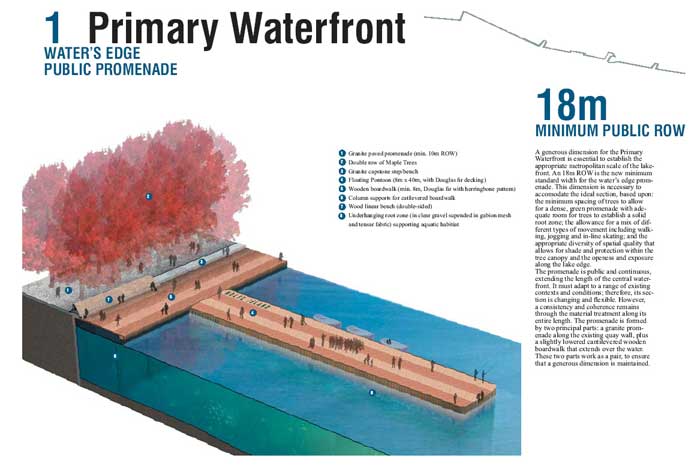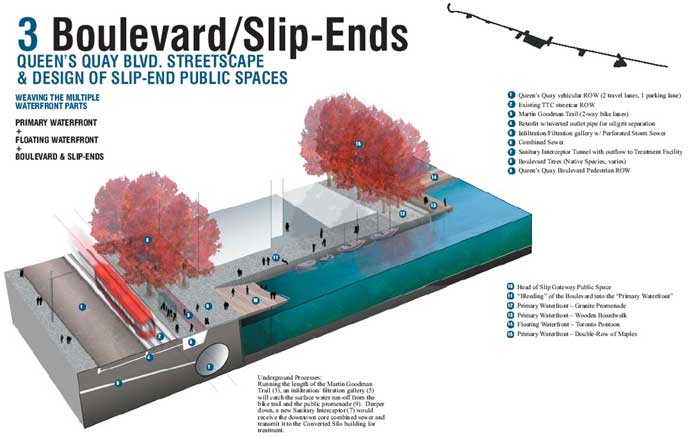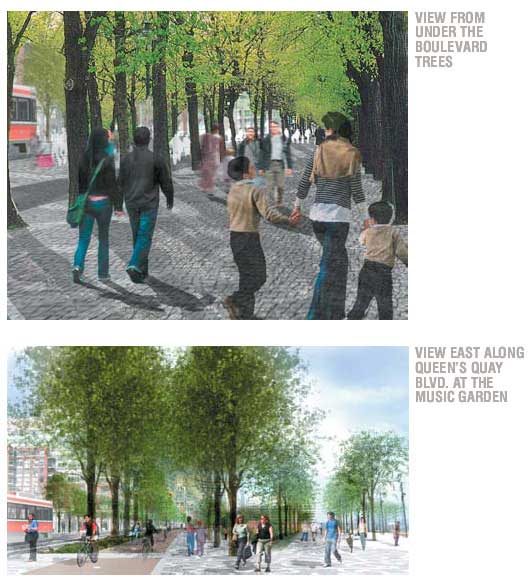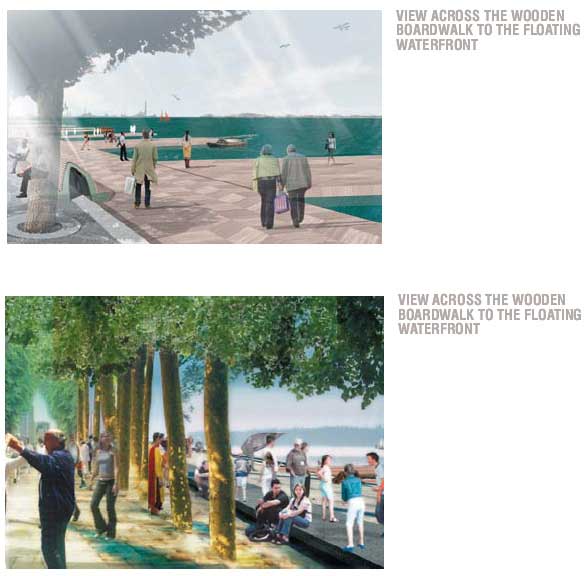West 8 / DTAH win Waterfront Design Competition
TWRC and the City today announced that the West 8 / Du Toit Allsopp Hillier team were the winners of the waterfront design competition. See TWRC and DTAH websites for details and many more images.
I think we all know the best proposal won. Let’s hope that the scheme goes through with the same principles (maybe sans giant floating maple leaf).
ADDENDUM:
The winning scheme proposes the demolition of the Gardiner Expressway, to be replaced with a Champs Élysées-style boulevard, but it’s attitude towards the railway corridor (the real barrier to the waterfront) is more ambiguous. Knowing Toronto’s politics and methodology, the danger of insisting upon pinning the scheme to the demolition of the Gardiner is delaying design development or construction until agreement can be reached on the Gardiner (and that might be akin to waiting for Hell to freeze over).
Alternatively, going ahead with the Queen’s Quay, slip, and waterfront promenade work without a commitment to demolishing the Gardiner would fulfill the mandate of the competition’s terms of reference, while giving little leverage to force action on the Gardiner question. This whole issue is aggravated by the fact that the existing development along the north side of Queen’s Quay deliberately turns its back on the Gardiner (for obvious reasons), and consequently Queen’s Quay operates quite independent of the Gardiner/Lakeshore Boulevard co-dependency. It is therefore hard to practically argue that a Gardiner demolition is essential to the work on Queen’s Quay.
We’ve seen this play before – some of us might remember the euphoria that accompanied the Fung report and the release of the Making Waves Part II Plan for the Waterfront, both of which gave the impression that the Gardiner would soon be a piece of history, until the Front Street extension became TWRC’s first priority – a project that now seems to be on hold, but which is a constant threat hanging over the Gardiner’s future.
Adrian Geuze of West 8 might be blissfully unaware of the machinations of the Toronto undercurrents, but that doesn’t mean that the proposal to demolish the Gardiner is wrong. The idea of a Champs Élysées-style boulevard is in fact a huge leap forward since most other schemes have proposed a tunnel (akin to Boston’s hugely expensive Big Dig) which is tantamount to accepting the failure of the whole idea in advance.
I think the issue of the Gardiner is so divisive that I wouldn’t be surprised if it became a mayoral election issue in much the way the fixed-link to the Toronto Island Airport became the issue that galvanised David Miller’s win in the last race. There are enough drivers who adore the views and experience of driving the Gardiner (regardless of the cost to the city and the waterfront) and functional transportation thinkers who have a hard time imagining how the boulevard could make up the capacity of the Gardiner, that I would be worried to rely on a plebiscite to settle the issue.
There is the additional oddity that along the western waterfront there are three directly parallel and adjacent large roadways all making their way towards downtown – Lakeshore Boulevard (6 lanes?), the Gardiner (not raised, 6 lanes?), and the Queensway (6 lanes?). My question is, if the raised downtown section of the Gardiner was demolished and replaced with a boulevard (presumably eliminating Lakeshore Boulevard which practically runs beneath it), would that then enable removal of one or two of these western arteries which pose such an enormous barrier between the western waterfront and the city?
If the Gardiner did ever come down, I can’t think of a better reason to dramatically improve the GO train service along the waterfront corridor. Improved service and frequency in both directions throughout the day could go a long way to relieving possible congestion or increased travel times resulting from a demolition of the Gardiner. A perusal of current schedules shows that frequencies aren’t too bad – except who wants to wait an hour for a train? Running a better service might require electrification of the lines (which allows quicker stopping and acceleration after a stop and therefore increased number of stops) possibly allowing for the running of local and express lines with better travel times than the Long Branch streetcar line. An integrated GO transit – TTC fare structure / transfer privileges wouldn’t hurt either. Hey, if we can dream about demolishing the Gardiner, surely we can dream about improved transit?






2 Comments so far
Leave a comment
[…] I reported on the result (with more images from the scheme) and set myslef a-musing on its possibilities in a post yesterday. Click images to enlarge! Enjoy. […]
By Bricoleurbanism » Toronto’s Future Waterfront a la West 8 / DTAH on 06.03.06 4:44 pm
Man you are quick on the uptake. Me, I’m still mulling over the winning proposal. What I like best about it is all the little “docks” that poke into the lake, and with that the rejection of the two main cliches about urban waterfronts: Rio de Janiero and Boston inner harbour. But I can’t help but think about another fact of “cottage life” that the winning proposal forgot or decided to ignore: the fact that in winter all those little docks are hauled on shore or dragged around to a sheltered bay. Will that be an annual occurance on our waterfront in years to come?
I’d be interested to hear your critique of the also-ran proposals. Each of them, like with the winner’s goofy maple leaf floater, had really silly ideas, but it seemed to me that each of them had really strong ideas too. I particularly liked the Todd Williams/Billie Tsien approach to the gardiner: build up to it with a berm on either side so it is “at grade,” then reverse “Lakeshore blvd” and “the Gardiner” so the expressway is buried, without any of the hassle and horror of Boston’s Big Dig (i.e. relocating centuries-old sewage tunnels).
By blobby on 06.03.06 7:57 pm
Leave a comment
Line and paragraph breaks automatic, e-mail address never displayed, HTML allowed:
<a href="" title=""> <abbr title=""> <acronym title=""> <b> <blockquote cite=""> <cite> <code> <del datetime=""> <em> <i> <q cite=""> <s> <strike> <strong>